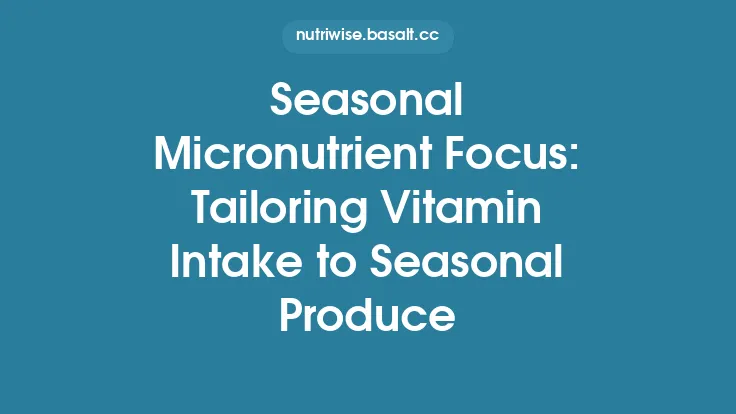Winter’s chill, spring’s rebirth, summer’s abundance, and autumn’s harvest each bring a distinct roster of plant and animal foods that naturally peak in flavor, texture, and, crucially, micronutrient content. By aligning our eating patterns with these seasonal cycles, we can tap into the most bioavailable vitamins, minerals, and phytonutrients the planet has to offer—without relying on processed “superfood” powders or year‑round imports that may have lost potency during transport and storage. This guide walks you through the science of seasonal micronutrient variation, outlines the hallmark superfoods for each season, and provides practical, evergreen strategies for preserving and maximizing their nutrient payload throughout the year.
The Science Behind Seasonal Micronutrient Peaks
Photoperiod and Phytochemical Synthesis
Plants synthesize many of their protective compounds—flavonoids, carotenoids, glucosinolates—in response to environmental cues such as daylight length, temperature fluctuations, and UV exposure. For example, shorter days and cooler temperatures in autumn stimulate the accumulation of anthocyanins in apples and grapes, giving them their deep reds and boosting antioxidant capacity. Conversely, intense summer sunlight drives the production of lycopene in tomatoes and β‑carotene in carrots, enhancing provitamin A content.
Soil Mineral Dynamics
Soil mineral availability also follows seasonal patterns. In early spring, mineralization of organic matter releases nitrogen, phosphorus, and potassium, enriching newly sprouted greens with higher concentrations of folate, magnesium, and potassium. As soils dry out in late summer, certain micronutrients (e.g., zinc) become more concentrated in root crops that draw deeper water sources.
Post‑Harvest Nutrient Degradation
After harvest, vitamins such as C, B₁ (thiamine), and folate are particularly labile. The rate of degradation is temperature‑dependent: refrigeration slows oxidative loss, while ambient storage accelerates it. Understanding these kinetics allows us to choose preservation methods that lock in micronutrients for later use.
Spring Superfoods: Reawakening the Body
| Food | Key Micronutrients | Why It Peaks in Spring |
|---|---|---|
| Asparagus | Folate, vitamin K, riboflavin, selenium | Rapid shoot growth demands high folate for DNA synthesis. |
| Ramp (wild leek) | Vitamin C, manganese, iron | Early emergence before canopy shade maximizes sunlight exposure for vitamin C synthesis. |
| Strawberries | Vitamin C, manganese, folate, anthocyanins | Warm days and cool nights stimulate anthocyanin pathways. |
| Spinach (young leaves) | Vitamin K, iron, magnesium, lutein | Cool, moist soils favor chlorophyll and lutein accumulation. |
| Peas (sugar snap) | Vitamin C, thiamine, folate, potassium | Legume nitrogen fixation enriches soil nitrogen, boosting folate in pods. |
Maximizing Spring Micronutrients
- Quick‑Cook or Raw: Vitamin C and folate are water‑soluble and heat‑sensitive. Lightly steaming or consuming raw preserves up to 90 % of these nutrients.
- Acidic Dressings: Adding a splash of lemon juice stabilizes vitamin C by lowering pH, reducing oxidative loss.
- Cold‑Chain Harvest: Purchase from local farmers’ markets where produce is harvested within 24 hours; this minimizes post‑harvest degradation.
Summer Superfoods: Fueling High Energy Demands
| Food | Key Micronutrients | Seasonal Rationale |
|---|---|---|
| Tomatoes | Lycopene, vitamin C, potassium, vitamin K1 | Intense sunlight drives lycopene synthesis as a photoprotective pigment. |
| Bell Peppers (red) | Vitamin C, vitamin A (β‑carotene), folate | Heat stress triggers carotenoid accumulation for oxidative defense. |
| Blueberries | Anthocyanins, vitamin C, manganese, vitamin K | UV exposure enhances anthocyanin pathways, providing antioxidant protection. |
| Sweet Corn | Thiamine, folate, magnesium, phosphorus | Warm soil promotes rapid kernel development, concentrating B‑vitamins. |
| Watermelon | Vitamin A, vitamin C, potassium, lycopene | High water content and abundant sunlight favor lycopene and vitamin C synthesis. |
Preserving Summer Nutrients for Later Use
- Flash Freezing: Blanch briefly (30 seconds for berries) then freeze at –18 °C. This halts enzymatic degradation, preserving up to 80 % of vitamin C and carotenoids for months.
- Low‑Heat Dehydration: Drying tomatoes at ≤55 °C retains lycopene while concentrating flavor; rehydrate for sauces without significant nutrient loss.
- Fermentation: Lacto‑fermented bell peppers develop probiotic cultures and increase bioavailability of vitamin C and certain B‑vitamins.
Autumn Superfoods: Preparing for the Cold
| Food | Key Micronutrients | Why It Peaks in Autumn |
|---|---|---|
| Pumpkin | Vitamin A (β‑carotene), vitamin C, potassium, magnesium | Shortening days trigger carotenoid storage in the fruit’s flesh. |
| Kale | Vitamin K, vitamin C, calcium, lutein | Cold temperatures up‑regulate vitamin C synthesis as a frost‑protectant. |
| Apples | Quercetin, vitamin C, potassium, fiber | Accumulation of phenolic compounds protects seeds from oxidative stress. |
| Brussels Sprouts | Vitamin K, folate, vitamin C, glucosinolates | Cooler weather enhances glucosinolate production, a sulfur‑rich defense molecule. |
| Pomegranate | Vitamin C, vitamin K, potassium, polyphenols | Late‑season heat spikes polyphenol synthesis for seed protection. |
Optimizing Autumn Micronutrient Intake
- Gentle Roasting: Roast pumpkin or Brussels sprouts at 180 °C for 20‑30 minutes; this softens cell walls, improving carotenoid and glucosinolate release while preserving vitamin C (≈70 % retained).
- Cold‑Press Juicing: Fresh apple or pomegranate juice extracted at ≤4 °C retains polyphenols and vitamin C better than high‑speed centrifugal methods.
- Storing in Controlled Atmosphere: Apples kept at 0–4 °C with low oxygen (1‑2 %) delay ethylene‑induced senescence, preserving vitamin C and quercetin for up to 6 months.
Winter Superfoods: Sustaining Micronutrient Levels in the Cold
| Food | Key Micronutrients | Seasonal Advantage |
|---|---|---|
| Citrus (oranges, grapefruits) | Vitamin C, folate, potassium, flavanones | Cold stress stimulates ascorbate accumulation as an osmoprotectant. |
| Root Vegetables (parsnips, turnips) | Vitamin C, potassium, manganese, B₆ | Underground storage protects nutrients from frost, concentrating them. |
| Dark Leafy Greens (collard greens, Swiss chard) | Vitamin K, calcium, magnesium, lutein | Frost exposure increases soluble sugar content, enhancing mineral solubility. |
| Seaweed (nori, kelp) | Iodine, iron, calcium, vitamin B12 (in some species) | Winter storms bring nutrient‑rich upwellings, enriching marine algae. |
| Persimmons | Vitamin A, vitamin C, manganese, dietary fiber | Late‑season ripening under cool nights boosts carotenoid levels. |
Winter Nutrient Retention Techniques
- Steaming Over Boiling: For root vegetables, steam for 8‑10 minutes; this limits leaching of water‑soluble vitamins compared with boiling.
- Canning with Minimal Heat: Pressure‑canning citrus segments at 115 °C for 10 minutes retains >80 % of vitamin C while ensuring safety.
- Incorporating Seaweed: Rehydrate dried nori in cool water (15‑20 °C) for 5 minutes; this preserves iodine and iron without the heat‑induced loss seen in cooking.
Integrating Seasonal Superfoods Across the Year
- Create a Seasonal Micronutrient Calendar
- Plot the primary superfoods for each quarter on a visual timeline.
- Note the dominant micronutrients (e.g., vitamin C in spring/summer, vitamin K in autumn/winter).
- Use this calendar to anticipate any potential gaps (e.g., vitamin D in winter) and plan complementary sources.
- Leverage Preservation to Bridge Gaps
- Freezing: Reserve excess summer berries for winter smoothies, maintaining antioxidant intake.
- Drying: Dehydrate kale into chips for a portable vitamin K snack during travel months.
- Fermentation: Keep a jar of winter‑fermented carrots to boost probiotic and vitamin C intake year‑round.
- Mindful Cooking to Enhance Bioavailability
- Fat‑Soluble Micronutrients: Pair lycopene‑rich tomatoes with a modest amount of olive oil; the lipid matrix improves absorption by up to 30 %.
- Acidic Medium: Cook kale with a splash of lemon juice; the acidic environment converts calcium into a more absorbable form.
- Heat‑Activated Enzymes: Lightly sauté garlic with Brussels sprouts; heat releases alliinase, which can increase the bioavailability of sulfur compounds.
- Track Micronutrient Coverage Without Rigid Meal Plans
- Use a simple spreadsheet to log the primary superfood consumed each day and its key micronutrients.
- Summarize weekly totals to ensure that each micronutrient class (vitamin C, vitamin K, potassium, etc.) meets at least 80 % of the Recommended Dietary Allowance (RDA).
- Adjust future purchases based on observed shortfalls, focusing on the next season’s superfoods.
The Role of Regional Climate Zones
Seasonality is not a one‑size‑fits‑all concept; latitude, altitude, and local microclimates shift the timing of peak nutrient accumulation.
- Temperate Zones: Follow the classic four‑season pattern described above.
- Mediterranean Climates: Extend the summer window for tomatoes and peppers, while early‑fall may still yield high‑vitamin C citrus.
- Sub‑Tropical Regions: Winter may still produce leafy greens with robust vitamin K, but root vegetables become the primary source of vitamin C.
When traveling or sourcing produce from distant markets, consult regional harvest calendars to align your selections with the true physiological peak of each food, rather than the calendar month alone.
Closing Thoughts
Seasonal superfoods are more than a culinary trend; they are a biologically tuned delivery system for the micronutrients our bodies need to thrive. By understanding the environmental triggers that drive nutrient synthesis, selecting foods at their peak, and employing preservation and cooking methods that safeguard those nutrients, you can construct a resilient, year‑round micronutrient strategy without the need for synthetic supplements or generic “all‑season” produce that may have lost potency. Embrace the rhythm of the seasons, and let nature’s own calendar guide you to optimal health.





